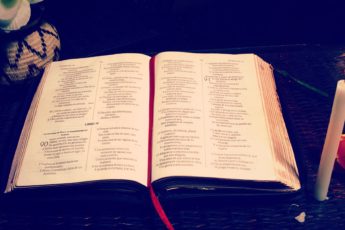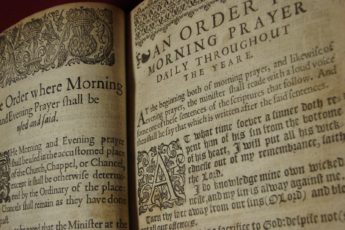Living the life of Jesus: the seasons of the Christian Year

The Christian Year is a way of ordering the calendar, one that can help us learn to live as children of God in the midst of people who order time according to very different priorities. The Christian Year is a rich resource for spiritual formation. The passing of time and seasons become opportunities for a new kind of worship, one in which we give sustained attention to the major events of Jesus’ life: his birth, baptism, ministry, death, burial, resurrection, ascension, and the coming of the Holy Spirit to the church. These events become vehicles through which we learn the rhythms of the good life Jesus demonstrated for us and into which we are called.
We touched on four brief reasons why ordering our time according to the Christian Year has such formative power in God’s hands. Now, let’s introduce the major cycles and seasons of the Christian Year.
The Christian Year is broken into two (or perhaps three) major cycles:
The Cycle of Light
Beginning four Sundays before Christmas, the Season of Light is a season celebrating the rich mystery of the Incarnation, God breaking into our world: not with angels or disembodied commandments but with his very self, becoming one of us. The central mystery of this cycle is that of promises fulfilled. We look back at the longing of Israel for the fulfillment of messianic promises and enter into this longing as we look forward to the end of the age when God’s promises will come fully and finally to pass. The Cycle of Light consists of Advent, Christmas, and Epiphany.
Advent: Advent is a season of expectation, a time when we enter into Israel’s historic anticipation of the messiah and savior long-promised by the prophets. Though Jesus has already broken into our world, his work is not yet complete. Part of the celebration of Advent is to enter into the longing of our world for healing, peace, and justice, for Jesus to bring to full completion the restoration of all things.
Christmas: Christmas is a season of celebration—the promise of a savior has been fulfilled. Jesus has been born among us and we stand in awe of the angel’s proclamation: “Do not be afraid; I bring you good news that will bring great joy to all people.” The light of the world is born and a new day dawns as a result of this reality. Now we shake the world with the sound of our joy!
Epiphany: Epiphany is a season of proclamation that follows the revelation of who Jesus really is in all his glory. We celebrate the baptism of Jesus and the inauguration of his ministry as he proclaims “the time is fulfilled, repent and believe the good news.” As we yield to the mystery and authority of this revelation, we allow Jesus to manifest himself in us and through us to a watching world.
The Cycle of Life
Beginning with Ash Wednesday six weeks or so before Easter, the Cycle Life is the season that celebrates the death and resurrection of Jesus. God did not come merely to teach but to take the sin of the world on himself, to destroy the power of death, Satan, and the powers, and to open wide the path to the rich, good life that God desires for all people. The central mystery of this cycle is that of abundant, overflowing, eternal life—life that cannot be quenched and that spills out into the world, the evidence and power of new creation. The Cycle of Life consists of Lent, Easter, and Pentecost. These seasons follow the same type of pattern as the previous three: expectation, fulfillment, and proclamation.
Lent: Lent is the season in which we journey with Jesus toward the cross, learning again to die to the sin that still besets our lives, learning to live each moment by the grace of God. We begin Lent with Ash Wednesday, recalling our mortal nature and the short time we have on the earth to live and love. Often, people will choose some kind of fast to help them take up their cross daily as they go deeper in their apprenticeship to Jesus, pouring out their own lives to receive new life in him.
Easter: Easter is the highest moment of celebration in the Christian Year. The fulfillment of all God’s promises is before us in the shining, empty tomb. While the world upended all its violence and rebellion on Jesus and the prince of this world thought himself victorious, the grave could not hold him. God raised Jesus from the dead and a new age has dawned. The Three Great Days (Good Friday, Holy Saturday, and Easter Sunday) are the high point of the Christian Year and the very center of our faith.
Pentecost: The mission of God did not end with Jesus’ resurrection. He ascended to the right hand of the Father and then sent the Holy Spirit on the church, sending all disciples into the world to baptize in the name of the Father, Son, and Holy Spirit, teaching them to obey everything Jesus commanded. This is a season to live ever more deeply in step with the Holy Spirit of God.
“Ordinary Time” (or the Cycle of Love)
Following the completion of the Pentecost season is so-called “ordinary time”, where the church moves through the remaining range of Jesus’ teaching, a season in which we apply ourselves to reflecting on and becoming more obedient to our Lord. At least one author refers to this as a third cycle, the Cycle of Love. This season ends with All Saints Day, where the church reflects for a season on the Communion of Saints, all those living and dead that are heirs of eternal life, the great cloud of witnesses that spurs us on to love and good deeds.
If you’re looking for more on the theology and practice of observing the Christian Year, I recommend two excellent resources:
Robert E. Webber, Ancient Future Time: Webber does an excellent job drawing out the deep theology of the Christian Year especially for protestants who don’t come from church traditions that celebrate it. It offers simple and helpful charts for the beginner with lots of insight into the symbols and rhythms of the Christian Year.
Bobby Gross, Living the Christian Year: Gross introduces the Christian Year and spends perhaps a little less time working through the symbolic power of the season, instead offering week by week meditations that fuel reflection.
* note: we are able to fund our ministry by the small fees we earn from the above affiliate links. Thanks for supporting us!









Leave a Comment